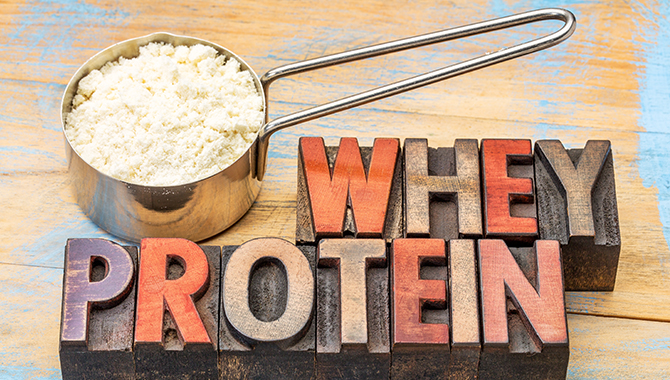There’s a new emphasis on protein in the American diet. According to Stu Phillips and others, the current recommendation of 0.8 grams protein/kg of body weight may not be adequate to maintain or develop lean mass, control appetite and reduce the metabolic effects of America’s love affair with refined grains. Adequate daily intake may be closer to 1.2 grams/kg. For a woman who is 5’4” and on a traditional weight loss diet with a 50/20/30 distribution, this may mean an intake of about 60 grams. Recent data suggests that those wishing to lose body fat and maintain muscle actually need 2-2.3 grams of protein/kg of body weight.
Either way, it’s time to reconsider protein needs, the timing of protein and convenient sources for clients.
How Whey Can Help
Whey protein comes from milk and represents about 20 percent of the protein found in milk. The benefits of adding whey are well documented and include body fat management, lean mass gains (especially when coupled with resistance training) and the prevention of sarcopenia. The challenge for you is to guide clients to the most appropriate whey protein for their needs.
For the Lactose Intolerant
The types of whey protein on the market vary – the more concentrated the protein, the lower the lactose. For those who need to avoid lactose, hydrolyzed whey and whey protein isolate contain the lowest amounts. Aim for products with protein concentrations above 90 percent.

Certified Products
In the world of label reading, we all know that the nutrition facts panels on supplements can be interpreted as “poorly regulated,” so in choosing a whey protein product, it’s best to look for those that are either NSF certified for sports or Informed-Choice certified. If you’re working with athletes, you must recommend a certified product. Aegis Shield, the new kid on the block, is also a third party certification agency – stay tuned for more information from them.
Affordability
We know when an ingredient is extracted from food, the price can often escalate as well. This may make whey protein powder less affordable for low-income families who might truly benefit from it. I have a solution that uses dry milk powder!
Using dry, non-fat milk powder in recipes is not meant to be a milk replacement, but rather a way to quickly and inexpensively add protein to your client’s meals. Dry milk powder can be mixed in water to form a slurry and can be added to non-protein foods such as oatmeal and mashed potatoes. It also works well to add to canned tomato soup or other creamy soup varieties. Although it is a good source of dairy protein, it does contain lactose, so seek alternatives for clients who are lactose intolerant.
Looking for more info on incorporating whey into the diet? WheyOfLife.org is a good resource.




